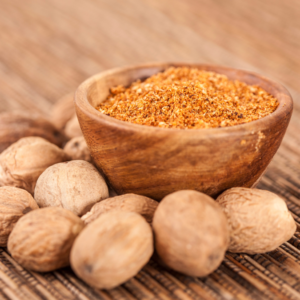Nutmeg: A Spice of Many Virtues
Exploring the Flavorful Journey and Multifaceted Benefits of Nutmeg in Global Cuisine
Nutmeg, or Myristica fragrans, is a spice that originates from the nutmeg tree, indigenous to the Banda Islands in the Moluccas (or Spice Islands) of Indonesia.
This spice, the seed of the tree, and mace, derived from the seed covering, have played pivotal roles in culinary traditions and healing practices around the globe.
Nutmeg’s warm, nutty, and slightly sweet flavor makes it a versatile ingredient, favored in both sweet and savory dishes across various cuisines.

Culinary Uses
Nutmeg’s versatility in the kitchen is unmatched. It is a cherished addition to desserts such as pies, puddings, custards, and spice cakes, where it contributes a warm depth of flavor.
Savory dishes also benefit from its rich taste; soups, stews, sauces, vegetable dishes, and meat preparations are all elevated with a hint of nutmeg.
Furthermore, it is a key component of several spice blends, including the Indian garam masala, Caribbean jerk seasoning, Middle Eastern za’atar, and the Western pumpkin pie spice, showcasing its global culinary appeal.
Health Benefits
Beyond its culinary uses, nutmeg is revered for its potential health benefits. It contains compounds that may offer antioxidant, anti-inflammatory, and antimicrobial benefits.
Nutmeg has been used in traditional medicine to treat various ailments, from digestive issues to insomnia and even as a remedy for pain relief. Modern research suggests that nutmeg could help improve mood, enhance blood circulation, and promote digestion.
However, it’s important to note that nutmeg should be consumed in culinary amounts; excessive consumption can lead to nutmeg intoxication, a condition caused by myristicin, a natural compound found in nutmeg.
Nutritional Profile
Nutmeg is a good source of minerals such as manganese, which plays a crucial role in bone health and blood clotting, copper, essential for energy production and iron absorption, and magnesium, important for muscle and nerve function.
It also contains vitamins like vitamin B1 (thiamine) and B6 (pyridoxine), which are vital for brain health and energy metabolism.
The spice also offers dietary fiber, contributing to digestive health and aiding in the prevention of chronic diseases.
Cultural Significance
The history of nutmeg is as rich and complex as its flavor.
Once more valuable than gold, nutmeg was a symbol of wealth and power in the Middle Ages in Europe.
It was believed to ward off the plague, and its rarity led to the Spice Wars, with European powers vying for control of the Spice Islands.
Nutmeg’s cultural significance extends beyond its economic value; it has been used in traditional ceremonies, as a natural remedy, and even as a protective charm.
Culinary Tips and Techniques
To fully harness the aromatic qualities of nutmeg, it is best grated fresh from the seed. Pre-ground nutmeg, while convenient, often lacks the potent flavor and aroma of freshly grated nutmeg.
A microplane or nutmeg grater can be used to grate the spice directly into dishes, releasing its essential oils and enhancing its flavor profile.
Nutmeg pairs exceptionally well with dairy-based dishes, adding complexity to cheese sauces, béchamel, and custards.
Its affinity for creamy textures also makes it a classic addition to beverages like eggnog, mulled wine, and chai tea, where it contributes a warm, comforting spice.
Sustainable Practices
In recent years, there has been a growing emphasis on sustainable sourcing of spices, including nutmeg.
Sustainable farming practices not only ensure the long-term viability of the nutmeg tree but also support the livelihoods of farmers in the Spice Islands and other regions where nutmeg is cultivated.
Consumers are encouraged to seek out ethically sourced nutmeg, contributing to the preservation of both the environment and cultural heritage associated with this treasured spice.
Conclusion
Nutmeg’s unique flavor, nutritional benefits, and rich history have cemented its status as a beloved spice worldwide.
From its origins on the Spice Islands to its presence in kitchens and medicine cabinets around the globe, nutmeg continues to be a symbol of culinary exploration and natural healing.
Whether used in a traditional pumpkin pie spice blend or as a subtle addition to a savory stew, nutmeg adds a touch of warmth and complexity that enhances the overall taste of a dish.
Its continued use in culinary and medicinal practices speaks to the enduring appeal of this versatile spice.
As we embrace the flavors of nutmeg, we also celebrate the rich cultural tapestry it represents, reminding us of the interconnectedness of our global culinary heritage.